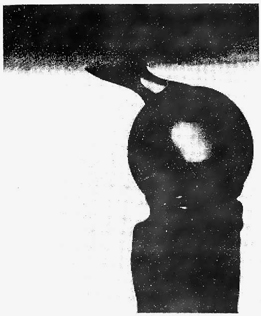Viscous Friction and Capillary Drag
Skis (as well as ice skate, sleds and other such winter equipment)
glide because, some what ironically, of their friction. The friction that
does exist between the ski and snow melts a little snow to create a very thin
film of water.

image from the Physics of Skiing
The energy that creates this heat comes directly from the Kinetic Energy of
the skier. The Kinetic Energy is reduced and thus also the speed is reduced.
This loss of velocity to create the thin film of water is called Viscous Friction.

image from the Physics of Skiing
Capillary drag comes from the surface tension of water. The picture above shows
how water clings to the bottom of a ski and stretches. The water is exerting
a slight force on both the marble and the ski. In snow, columns of water form
in the airspaces between the snow crystals. These myriad columns act like the
water droplet pictured above and pull on the ski. The wetter the snow is and
the thicker the film of water is, then the stronger the capillary drag is.

